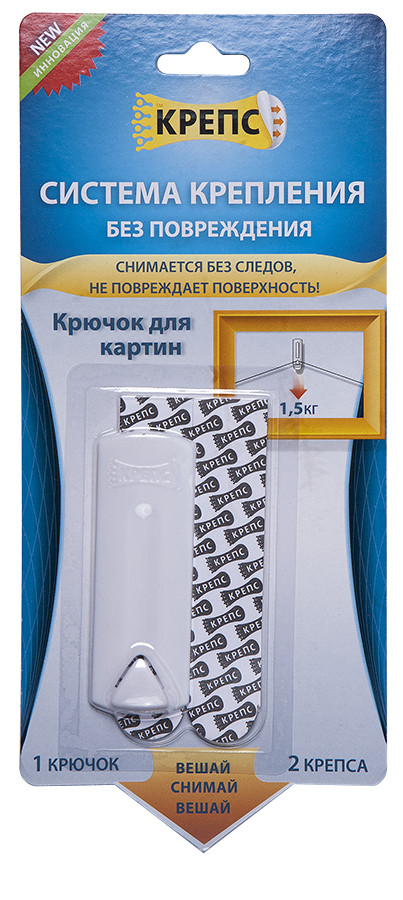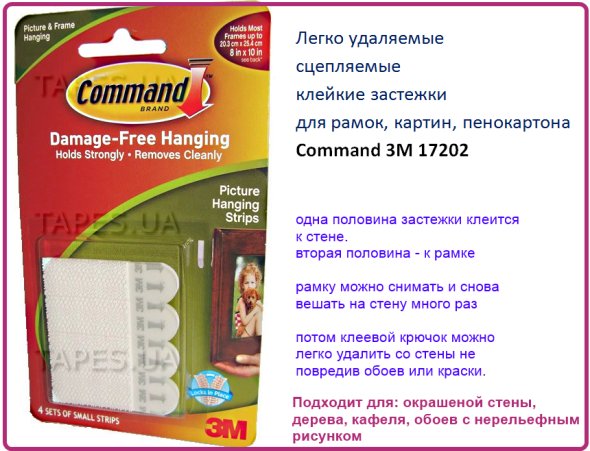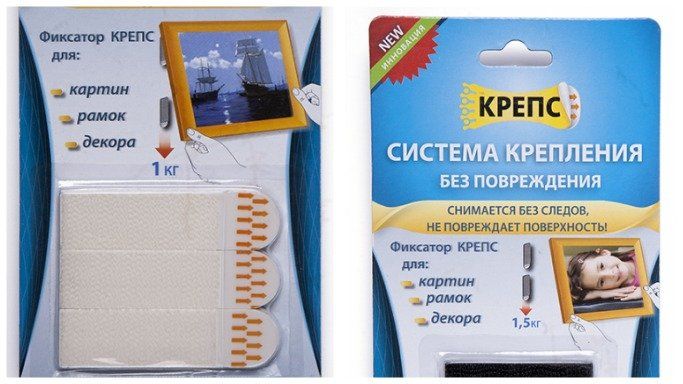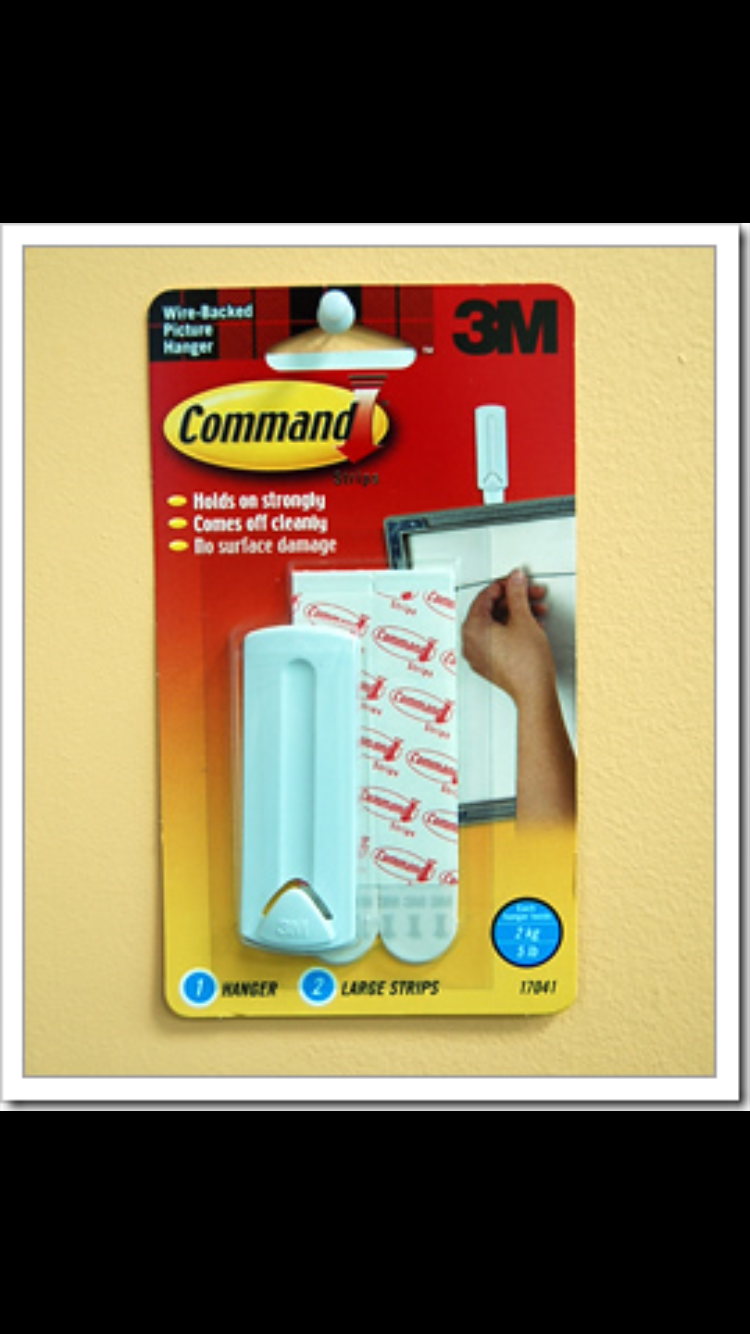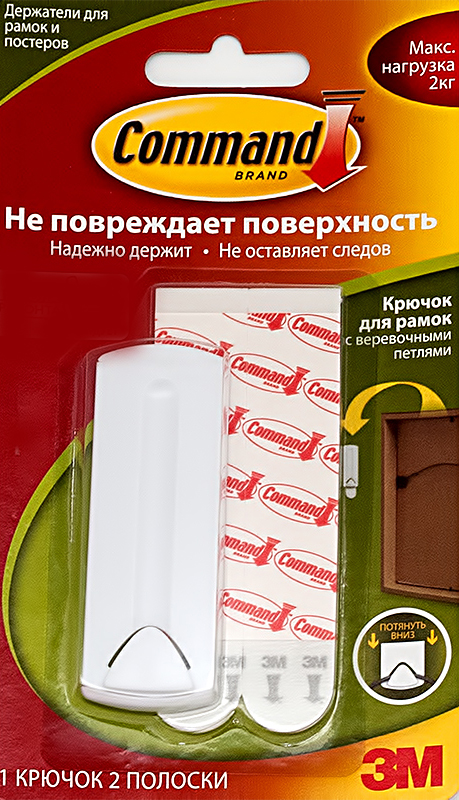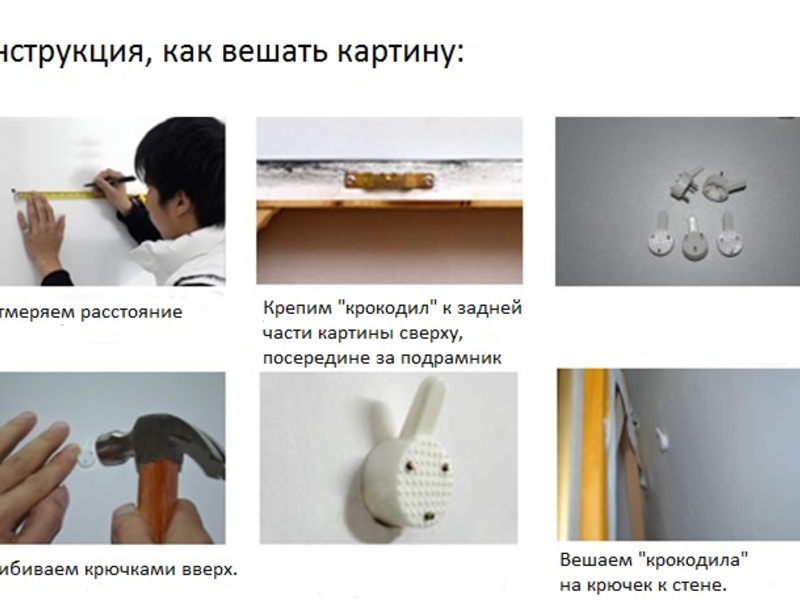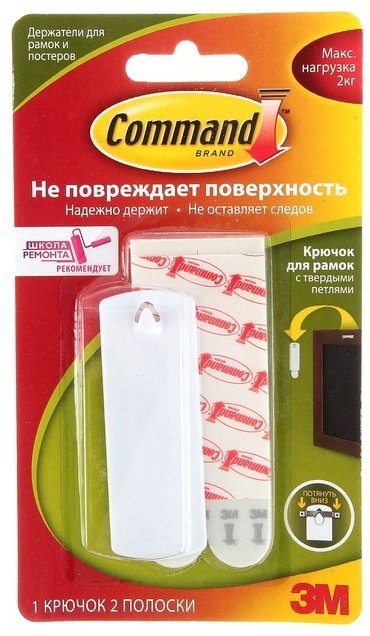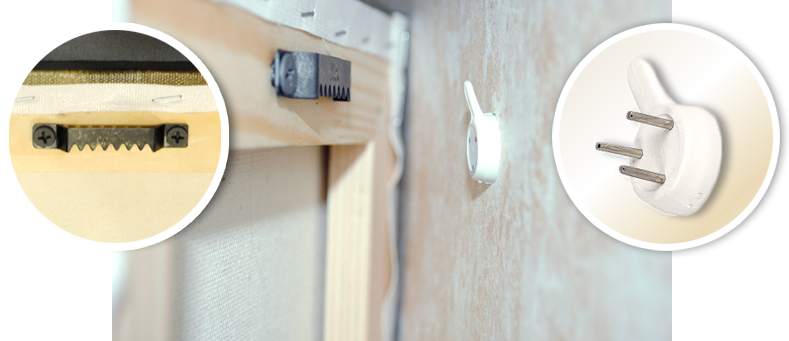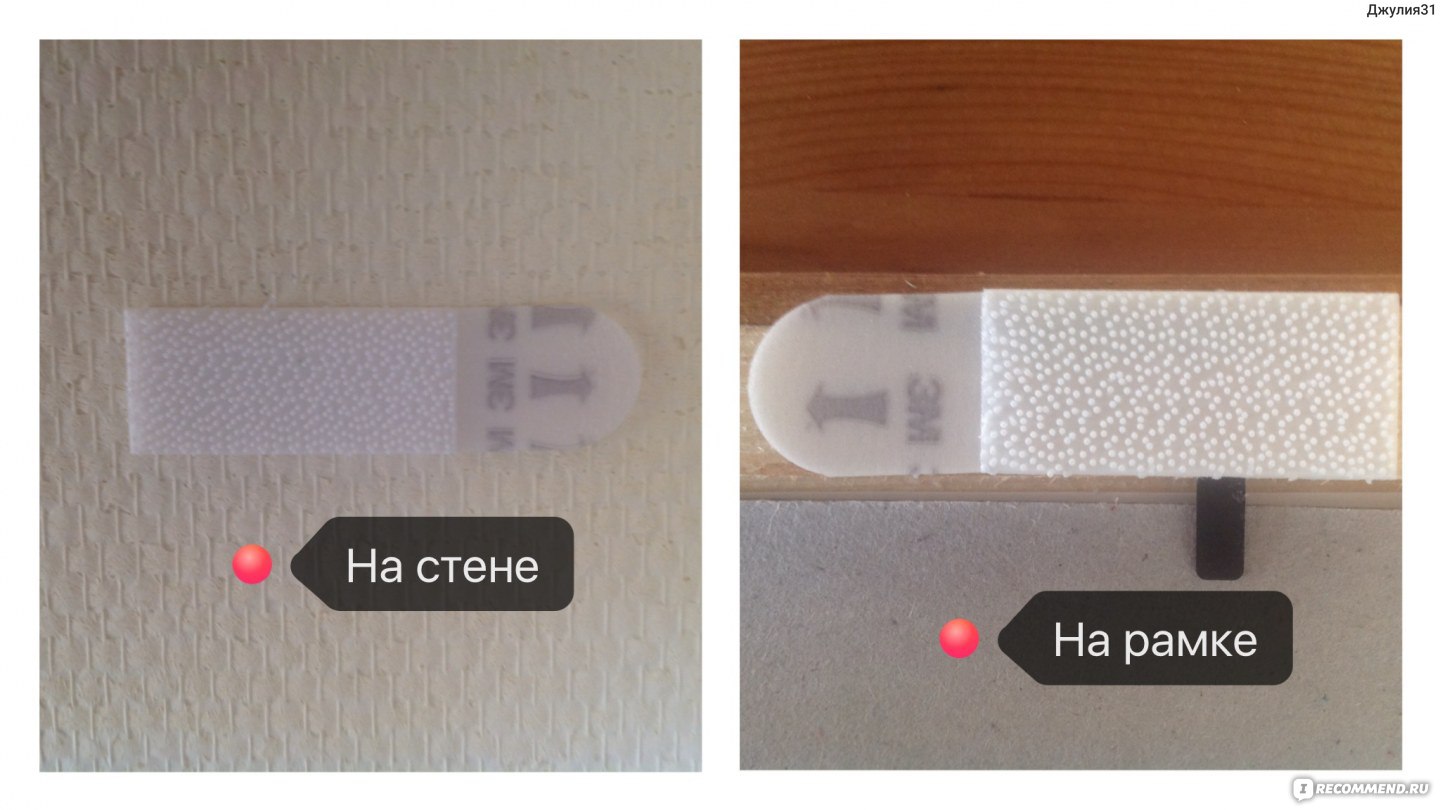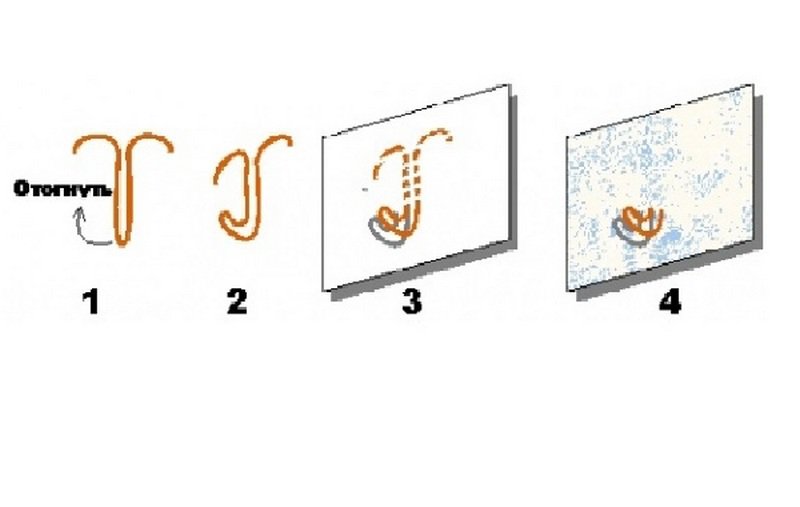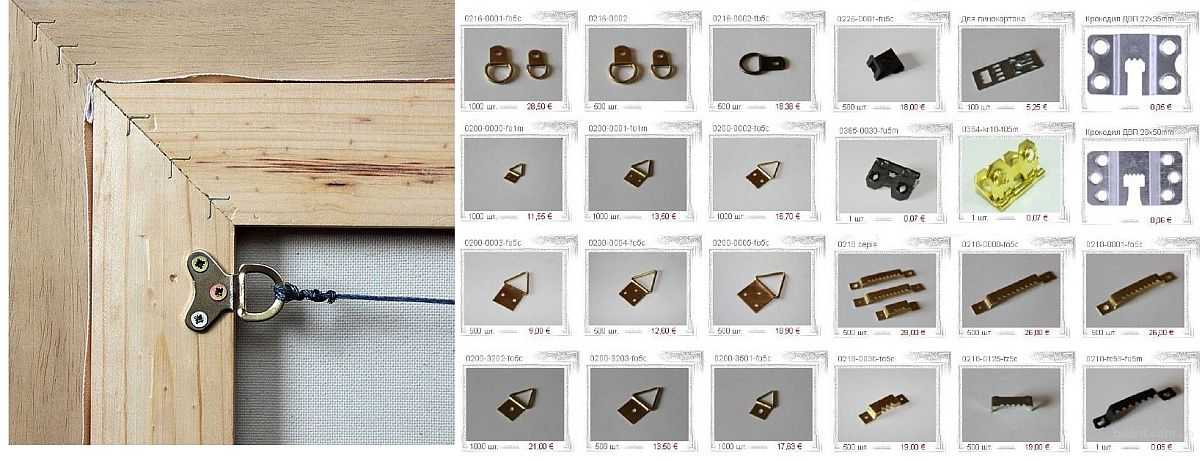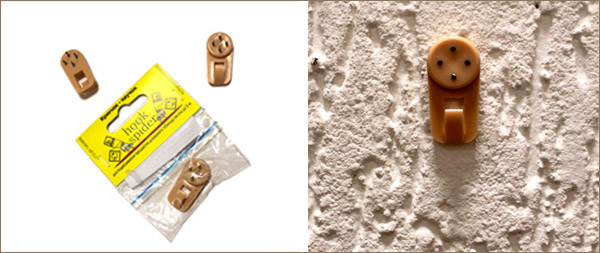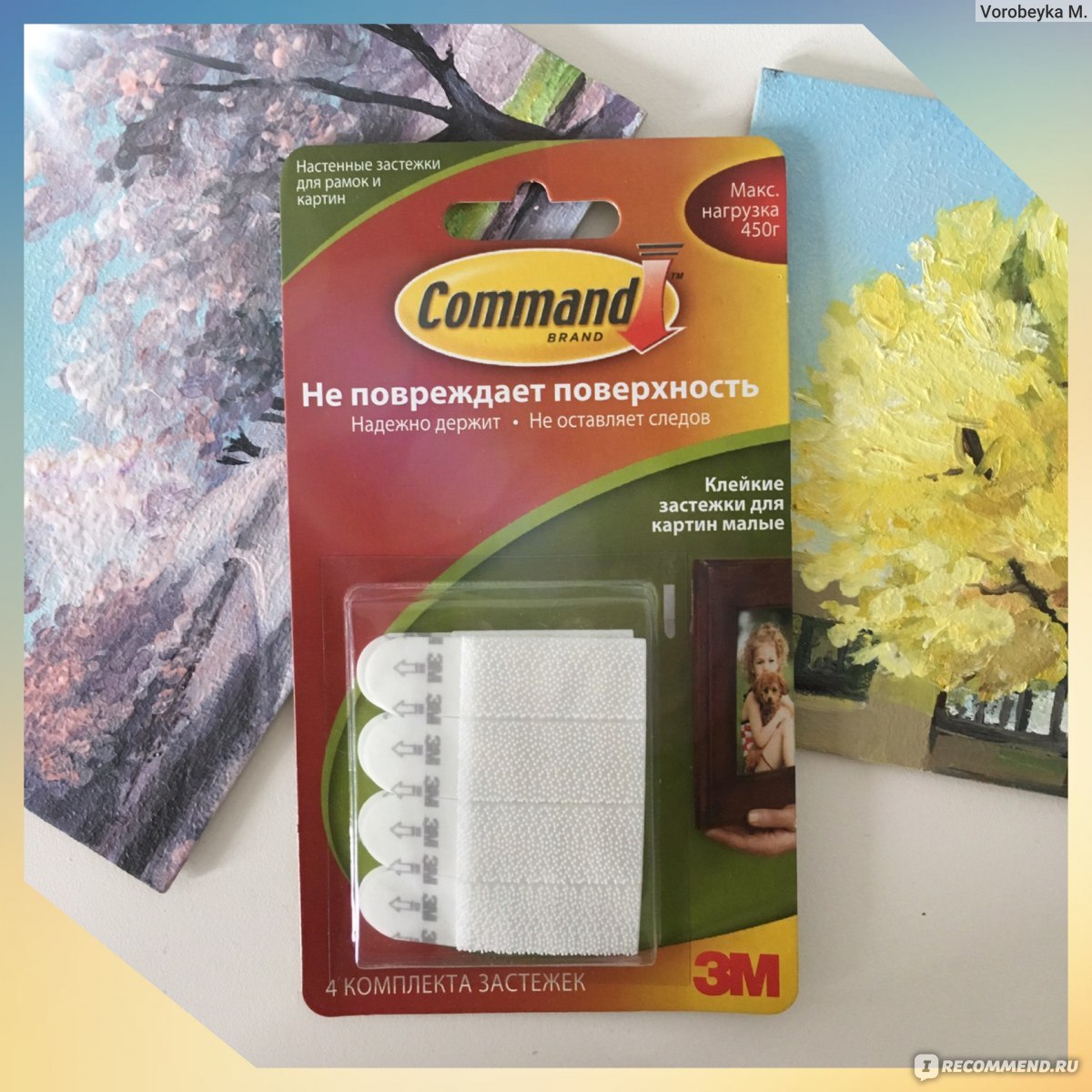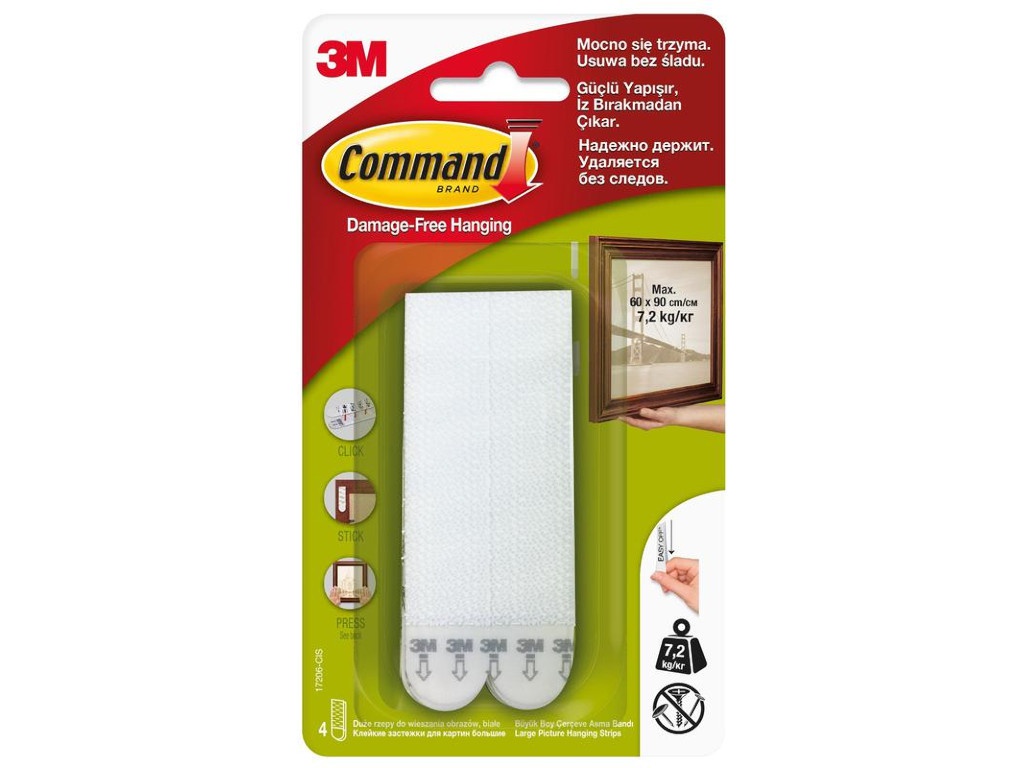How to hang a painting without drilling. Mechanical methods
As a rule, nails and screws leave behind rather large holes and even chips that look unaesthetic and the holes from them must subsequently be repaired and painted over.
And then simple but effective ways of attaching pictures come to the rescue. There are several of them, and you will definitely find a suitable option for yourself.
No. 1. Paperclip or hook
This method is suitable for walls covered with wallpaper. On the wall, in the place where you want to hang the picture, make a horizontal cut. Fill the incision with superglue and insert a paperclip there, having previously bent it in the form of a hook. You can also use a clothes hook as an attachment. We cover the place where we glued a paper clip or hook with wallpaper. This mount is suitable for not very heavy paintings.

No. 2. Button
Fastening with a button is done as follows: make an incision on the wallpaper, pour glue there, stick the button there and hide the base of the button under the wallpaper. All fasteners are ready! Such a mount is able to withstand a not heavy picture.

No. 3. Spider hook
Such fasteners are sold in hardware stores, it is called a "spider hook". The mount has four sharp ends that attach well to the wall with a hammer. The hook will hold a painting weighing about two kilograms and is securely attached to any wall.

No. 4. Needle
What kind of interior item is such a fastener designed for?
This type of fastener is able to withstand a light painting or drawing.
To do this, take a sewing needle and stick it into the wall. You can also carefully drive a tailor's pin into the wallpaper.
They also break off the eye of the needle and carefully drive it into the wall with a sharp end. The hole from the needle is small and invisible, unlike screws and nails
Since the needle is made of steel, it has good strength and will hold the painting securely.

No. 5. Double-sided tape
Such fasteners are suitable for walls that are covered with thin paper wallpaper and for drywall partitions. The scotch tape just needs to be glued to the edges of the frame and pressed against the wall so that the picture adheres well to the wall surface. But this method has a minus, used double-sided tape after removing the picture, leaves sticky marks. To avoid this, you need to keep the tape at a 90 degree angle to the wall when you shoot the picture.

No. 6. Velcro Command
Such a mount can be glued to any surface, they can withstand paintings up to two kilograms.
Command Velcro is very easy to remove from any surface. Velcro is sold in a set of several. The principle of operation of Command Velcro is as follows: one Velcro is glued to the picture frame, the other to the wall surface. The weight of the picture depends on the number of stripes, that is, the more stickies, the greater the weight of the picture.
No. 7. Wine cork
A regular wine cork is cut into 1 cm thick washers and glued to the wall with glue that dries quickly. After the washer from the cork is glued, a small nail is driven into it, it will serve as a mount for the picture.

No. 8. Ceiling plinth
This method is suitable for those who want to hang many paintings and not damage the walls. Moldings () are sold in hardware stores or markets. They are usually simply glued to the wall or ceiling, and then a strong fishing line is attached to it and only pictures are hung on the fishing line.

How to hang a painting on a wall without drilling the walls
How do you hang pictures if you don't want to drill through the walls? We suggest using one of the following methods:
- A small picture can be attached to the wall with double-sided foam acrylic tape. One side of the tape is glued to the canvas, and the other to a prepared surface. There should not be a heavy load. There is also a drawback in such a fastening: it is not durable and after fastening with tape, visible residues remain.
- Hooks for clothes and special fasteners for paintings on a Velcro basis are attached in the same way as in the previous method, only the canvas is hung on the hook.
- On a plasterboard wall, the picture is also hung with the help of pins, paper clips, wound under the wallpaper and fixed with PVA, Moment glue. For a concrete wall, this method is also suitable, but the picture should be small.
- "Liquid nails" - this is the name of a special glue that holds pictures well. Therefore, they are used for fastening the canvas and the hook. With the help of them, the canvas holds for a long time, because if you tear it off, it means ruining both the picture and the wall. This method is used to hang large paintings, as well as decorate the decoration in the kitchen and bathroom.
- Fast drying adhesives are also used in the following process. A small piece of wine cork, about 1 cm thick, must be glued to the cleaned wall. Then, as soon as the glue dries, a screw or nail is fixed in the cork, on which the picture is hung.
- There are also non-fusible metal hook nails. They are designed for various walls, they are well driven in without leaving any traces. Such nails can hold a heavy load.

Options for attaching paintings to the wall without nails
It often happens that when there is one thing, there is no second, and then vice versa. So, when you want to assign your picture to its place, where it will hang, and not gather dust on the shelf, it turns out that there is now a nail or a hammer.
A creative person knows more than one fastening of paintings to the wall without drilling
Pay attention to the subtleties of completing each task in order to correctly and aesthetically bring your plans to life
 There are a lot of options for attaching paintings. The main thing is to be smart and be creative.
There are a lot of options for attaching paintings. The main thing is to be smart and be creative.
Tailor's pin
Creativity in the case of a tailor's pin is appropriate if the weight of the picture does not exceed half a kilo. This method clings to: painting, small products and photography.
Consider what kind of coating is on the wall - paint or wallpaper. In the case of paint, you will need to take a small piece of paper, glue it to the wall and stick a pin into it.
In the case of both, everything happens exactly the same. Thin or loose-fitting paper is an exception. Attach the painting to the place where you will place it, circle it with a pencil or chalk. Cut it out. Pick up a thick piece of paper of the size you cut, glue and secure the pin. Ready.
 This mounting option is suitable only for a picture of small dimensions and weighing no more than 500 grams.
This mounting option is suitable only for a picture of small dimensions and weighing no more than 500 grams.
Double sided tape
Easy and reusable fastening method. Allowable weight for paintings: up to 2 kilograms. Glue exactly the scotch tape in the place where you will place your work and attach a picture to them. The positive side of the method: lightness, the ability to apply on plasterboard walls and light wallpaper. Negative side: when there is a desire to change the place for the picture or take it altogether, traces of scotch tape will remain in the place of the picture.
 On double-sided tape, you can hang a picture weighing no more than two kg.
On double-sided tape, you can hang a picture weighing no more than two kg.
Paper clip
The attachment will be the same as with the pin. Use a pair of tongs to bite off some of the paperclip so that the ends become sharp and stick it into the wall, wallpaper, or a piece of heavy paper. The experiment showed that the paper clip can withstand the weight of the picture up to 1 kilogram.
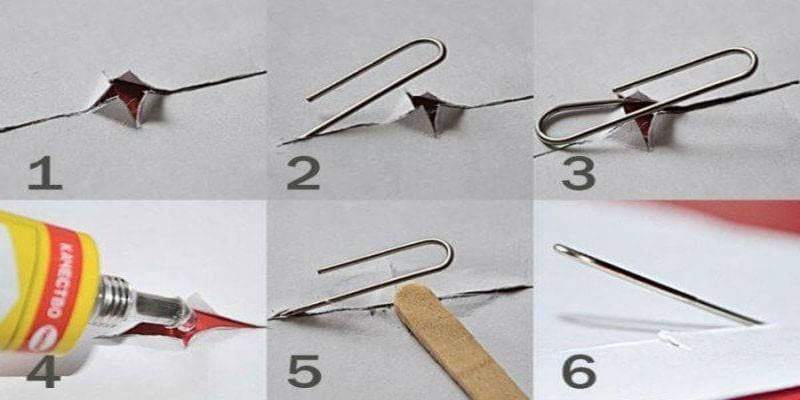 This mounting option is similar to pin mounting.
This mounting option is similar to pin mounting.
Spider hook
Not a handy way, but a good alternative to nails. Buy a spider hook from a hardware store.Pros: easy to attach, practically leaves no traces of attachment, for attaching paintings up to two kilograms. The attachment of such a spider is done with a hammer, a light blow, the hook is fixed in the wall with its four pointed ends.
 Spider hooks are available in different sizes. And depending on the size, they can withstand weight up to 8-9 kg.
Spider hooks are available in different sizes. And depending on the size, they can withstand weight up to 8-9 kg.
Velcro
They have a large selection of varieties. Basically it is a set of small sticky strips. Technique: one strip is glued to the frame of the picture, the second to the wall. Permissible weight: up to 2 kg. The more such mounts, the more weight they can hold.
 The following rule applies here - the more stickies, the more weight such a mount will withstand.
The following rule applies here - the more stickies, the more weight such a mount will withstand.
Cork
Option for small and medium wall paintings without drilling is possible. After the holiday, save the wine cork or remove it from your collection, if you have a similar one. Cut and glue with super glue (preferably quick-drying) to the wall. At this point, you can fix the fasteners.
 In every house there is for sure a cork from a bottle of wine. This method of mounting without drilling is possible for placing small pictures on the wall.
In every house there is for sure a cork from a bottle of wine. This method of mounting without drilling is possible for placing small pictures on the wall.
Cornice rail
A similar way can be seen in art galleries. At home, take an old cornice. You can also use a wooden strip, only you will need to attach hooks to it, like on a cornice. Pictures are hung to these hooks on a fishing line or loops.
 The cornice rail will allow you to place several paintings. They can be hung both at one and at different levels.
The cornice rail will allow you to place several paintings. They can be hung both at one and at different levels.
Liquid Nails
The material allows you to mount non-massive paintings without nails. The appearance of liquid nails with metal ones has nothing in common. They are more like superglue. Actions are performed in the same way. We cover the frame with glue and apply it to the wall
Pay attention to the evenness of the placement of the painting.
 Liquid nails are an adhesive that is a good alternative to regular nails.
Liquid nails are an adhesive that is a good alternative to regular nails.
How to hang a picture correctly (what is needed for this + principles of placing pictures in the house)
How to hang a picture so as not to spoil either the picture or the wall? What does that require? How do you learn to place the decor so that the design will only benefit from it? All these questions have their own answers. They will not be able to fit into one sentence, but it is worth preparing first, so that later you do not look for ways to fix what was done.
 Don't miss all the preparatory work. Before hanging a picture, you need to study the wall, measure the area and find the exact location of your picture, as well as decide on the type of attachment.
Don't miss all the preparatory work. Before hanging a picture, you need to study the wall, measure the area and find the exact location of your picture, as well as decide on the type of attachment.
Since designs and tastes are different, there is no one-size-fits-all advice on where to place a painting. Start your work by deciding where you want her to decorate the room. When doing this, consider:
- The size of the painting.
- The height of the ceiling of the room.
- Lighting.
- Line of sight.
Please note that paintings that are large in size will be appropriate to place on a wall with a large area, and small ones on a small one. Consider this fact of relevance, even at the stage of purchasing an accessory in a store
Take into account the geometry of the room, it is better to place a horizontal picture on a long wall, and a vertical one on a high one.
 An interesting option for placing paintings - for this, the area of the entire wall is involved. In this case, the main thing is to choose the right size and design of the structures.
An interesting option for placing paintings - for this, the area of the entire wall is involved. In this case, the main thing is to choose the right size and design of the structures.
The picture format has good visual features. By hanging a row of paintings in one vertical line, you can visually lengthen the wall. If you have chosen a place where you want the selected image to hang and the center of this image is at your eye level. It means that you are doing everything right.
 The arrangement of paintings on the same level will visually lengthen the room.
The arrangement of paintings on the same level will visually lengthen the room.
The order in the apartment should have been visible on everything: both in cleanliness and in aesthetics. Hang the pictures up to the same level.
 Choose pictures based on your feelings and tastes, do not be afraid to experiment.
Choose pictures based on your feelings and tastes, do not be afraid to experiment.
Markup methods
There are at least two ways to mark the wall for hanging modular paintings. The first is to circle the modules on the wall. Rather, mark the corners of each fragment. We start with the central element of the composition. We apply the fragments to the wall one by one, draw around the corners. Do not forget about the distance between the modules.
Modules often have different heights. In order to correctly position them relative to each other, select some moment that is present on at least two adjacent fragments. Make a mark on the wall (put a dot). On the modules that are in the middle of the composition, you need to put marks on the right and left. Place the next fragment according to the marked mark, move it to the specified distance, mark the upper corners.

Aligning a drawing by marks
When all the fragments are marked, we find the middle, set the selected fasteners at the desired height. The "desired height" is so that the top of the painting is at the mark it was made. It should be remembered that a stretched thread or an installed bracket / loop is placed on a stretcher. In principle, a deviation of two, three, four and even five centimeters from the marks is not critical.
It is important that the drawing on the fragments coincides
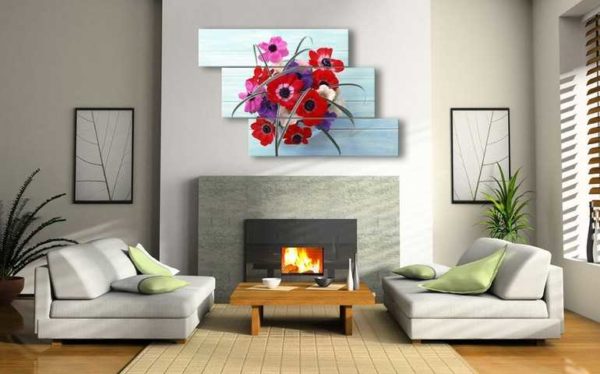
Horizontal modules are rare
The second markup method is probably easier. Take paper (newspapers, posters, leftover wallpaper, etc.), cut out copies of the elements of the modular picture. Exactly in size. Put marks on the paper (as described above) - so that you can correctly align the elements on the wall relative to each other. On the paper, mark where the loops / staples are installed, where the line is taut.
We place paper blanks on the wall. You can fix it with pins (on the wallpaper) or buttons. In this option, you can assess whether you have chosen the right location and make adjustments. As you can see, the option is more practical. Further, in the place where the mark was made (there is a bracket or loop in the picture), we attach the hook. It is even possible through paper. Then we tear off the paper, hang up the modular picture.
Modern fastening systems
Today, more modern and functional accessories and tools for renovation and modern design are produced almost daily. Progress also touched on fasteners for paintings and photographs.
Velcro for attaching pictures Command
This system can be used to hang a painting if there is no attachment on it, without damaging the surface of the wall. Velcro Command
are plastic fasteners that are attached to any type of coating.
Such Velcro consists of two parts and can be reused. In order to attach a picture using such fasteners, one should be attached to the wall, the second to the picture.
Before installing such fasteners, you should prepare the surface and degrease it. This will further increase your grip on the wall.

Hook for fastening the "Kreps" system
This system is intended for paintings, photo frames and other decorative interior items, which have special strings or cables as part of their accessories. This is due to the fact that the design provides for the presence of special hooks on its surface, which do not leave traces after dismantling and make it possible to hang the picture even on a concrete wall.
One such hook is capable of supporting a weight of 1-1.5 kilograms. But if you want to hang a large and heavy item, you can use multiple hooks at once. The most important thing is to correctly calculate the number and placement of these fasteners. The painting should fit snugly against the wall.
In order to install such a hook, you do not need much time, since it is a rather easy operation, and even a child can cope with it:
- You need to free one side of the protective layer and glue to the wrong side of the hook.
- After that, remove the protection from the other side and attach it to the wall.
- Hold in this position for about 30 seconds, after which you can safely hang decorative elements.
Dismantling is even easier. You just need to pull out the tongue, thanks to which the detachment will occur.
As you can see, there are many methods of how you can hang a painting, photograph, poster or other decorative elements without drilling huge holes in the wall. We have offered you the most popular and proven methods. Therefore, you can safely supplement the design of your room and change it at your discretion even every day.
Since ancient times, people have sought to decorate their home with a variety of decorative things: panels, photographs, masks, decorative hanging figurines, amulets, paintings.
Pictures were always hung on the walls, and sometimes situations arise when there is no way to drive a nail into the wall or screw in a screw, or there would be no one to do it.
We will talk further about the paintings, more precisely, about their mounting on the walls. Are we going to look at ten options? how to properly hang a picture using different mounts.
Backlight
Everyone has seen the decorative lighting of paintings in museums and galleries
Directional streams of light draw attention to the image, forcing you to stop and examine it in detail. In living quarters, natural light is recommended, because sunlight helps any subject to fully unfold.
Decorative lighting is needed only in two cases:
- On the glass protective surface of the painting, glare play, which interfere with the view of the plot.
- This decor element should become the center of the interior composition. Perhaps due to the neutrality of the plot or pastel colors, it is slightly lost in the setting.

It is better to use LED bulbs as a backlight. They will last a long time and do not heat up during continuous operation. A group of light bulbs in a metal "frame" against the background of a brick loft wall will look stylish and unusual. One above each painting.
Features of the placement of paintings
For the picture to look advantageous, it is important to choose the optimal place. The canvas should organically complement the interior
Seat selection
The painting should be located in a bright room. It should be borne in mind that frames with a still life or landscape attract maximum attention.
In this case, the canvas should not be in direct sunlight. Otherwise, the image will quickly burn out. In addition, it is advisable to avoid glare. This is true for paintings covered with glass.
Backlight presence
In dark rooms, paintings can also look very impressive. If there is not enough lighting, special illumination will help to accentuate the subject of the image. The luminous flux evenly covers the picture, without creating glare and shadows. Therefore, the source must be at a certain distance from the canvas.
Height selection
When choosing the height of the painting, you should take into account the peculiarities of the interior.
The height of the ceilings is also important.
It is recommended to look at the image at the level of human height. The bottom of the frame should be located in the eye area.
Before fastening, the product should be attached to the wall. This will help you assess the location of the canvas from the side.
Incline
Pictures placed at eye level are hung parallel to the wall. However, sometimes the top edge is slightly tilted. It depends on the height and preference of the person.
With the correct selection of the angle, the distance from a person's eyes to all points in the picture should be approximately the same. Thanks to this, it is possible to see the small elements much better. This method helps prevent glare.
Reliable ways
Consider how to hang heavier jewelry.Sometimes it is necessary to place a picture in a massive frame, a clock in a metal case, decorative panels or other things on the wall. It will not be possible to do with simple methods here, since an excessive load is unacceptable for them. You have to choose more reliable methods that allow you to get the expected result without drilling the surface of the walls. There are several good options that should be discussed in more detail:
Board for pictures
This option can be attributed to the most radical methods. For hanging pictures, a special plane is used, fixed on spacers to the ceiling plate and to the floor. It is possible to create a large shield, with pictures placed on both sides. To do this, the board is installed across the room, dividing the room into parts.
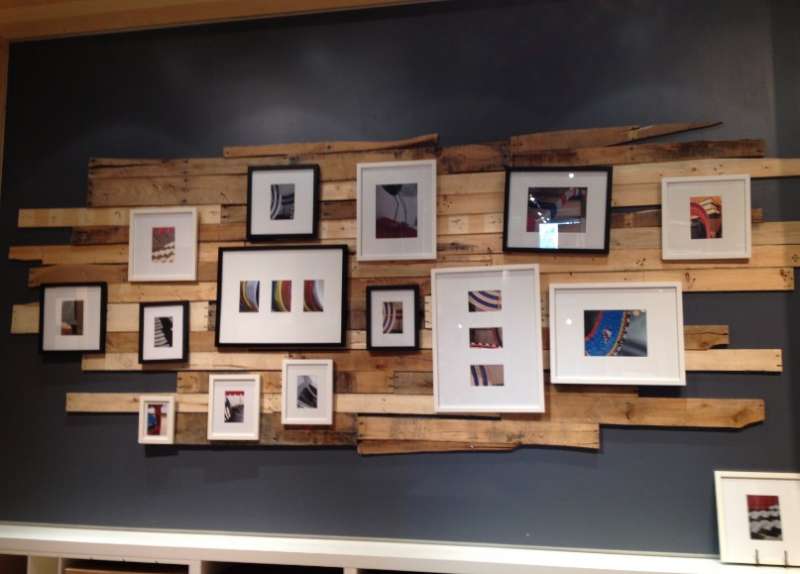
Since the fastening requires direct contact with the ceiling slab, rooms with suspended or suspended ceilings will not be suitable for this method. The plane itself can be made from any sheet material - MDF, chipboard, plywood or drywall. Natural boards connected in a shield or laminated materials are suitable. If desired, you can use the same material from which the furniture is made. This will help create a cohesive, stylish room interior.
Polymer glue
Polymer adhesives do not leave greasy marks on the wall. They are practical and relatively inexpensive. Users recommend polyurethane adhesive, which is durable and reliable. If you need to install a large picture, the entire frame around the perimeter is covered with glue. For products of medium size and weight, it is not necessary to apply the adhesive to the entire support surface. The picture is applied to the wall and propped up with some oblong object (stick, mop handle) and left overnight.

Liquid Nails
This composition allows you to fix the picture on the wall for a long time. The glue is quite thick, so there are no requirements for the ideal state of the wall. In addition, the composition is not afraid of moisture and is able to withstand significant loads. To the list of its advantages should be added high bearing capacity and durability. Liquid nails are sold in special tubes for a glue gun. The composition is applied to the surface with a solid wavy line or separate points over the entire area.

Orientation and tilt angle
As mentioned above, horizontal paintings visually expand the boundaries of the walls. They work well when paired with wide pieces of furniture: the back of a sofa or bed, a chest of drawers, a table, a bedside table. Vertical paintings, on the contrary, make the walls taller, stretch the space along a conventional line from floor to ceiling. They do not have to be tied to furnishings. Usually, groups of such decorative objects are decorated with ledges or short walls of corridors, rooms of irregular shape, sidewalls on both sides of wide doorways. Modular paintings, consisting of several vertical parts that form a single composition (diptychs, triptychs, polyptyches), look unusual. They should be considered only in aggregate, that is, as one large horizontal canvas, divided into sections.

The tilt angle is another important nuance that can affect the perception of the picture. It is adjusted by tensioning the rope of the fastener. Pictures located below and at eye level should lie in the same plane with the wall, that is, they should not have an angle of inclination at all. If the image is hung higher, then it can be slightly tilted so that the canvas seems to "fall" on the beholder. You will have to experiment with the angle of inclination to determine the optimal value.
The picture should not "put pressure" on a person, only unobtrusively attract his attention
How to make a "gallery" of photographs or paintings
Now very popular "collages" of several images arranged in a certain order close to each other. What is the best way to hang several paintings? You can apply one of these methods.
Suspended structure
To make such a structure, you will need a wooden plank (the rail of the old cornice) and strong nylon threads. If you are using a curtain rail, attach nylon threads of the required length to the inner hooks. In the case when the base of the structure is a strap, the threads can be fixed by simply "tying" one end around the device.
After that, the base of the structure is installed on the wall, and hooks, paper clips or other devices are attached to the ends of the threads, on which the paintings will be hung.
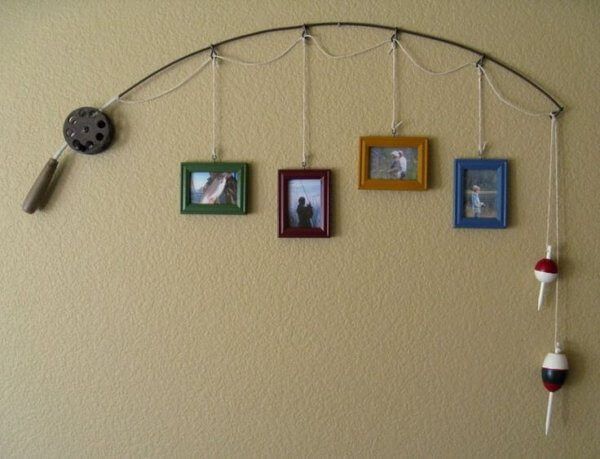
Wide tape
Satin ribbons of various widths and colors are available at sewing supply stores. Fold the material in half and attach it to the wall with a small stud. You can mount a hook in the wall, and hang the tape on it, after having sewn a loop to its back side.
A small hook is attached to the frame of the picture, for which it is hung on the tape. It should be noted that this method is suitable for small and light images; it will not work to hold a heavy decoration on the wall with a tape.
Board for pictures
This method will give your room a unique look. Choose a board that contrasts favorably with the main tones in the interior and stick it to the wall. Boards that are not close to the wall, but at some distance from it, look original.
You can place the base of the structure in this way using special brackets located at the top and bottom. You can hang images on the board in any way convenient for you, it all depends on your preferences. In this case, the wall will remain intact.
The tenth way - we use a suspended structure
If you are thinking about how to hang a picture without drilling a wall under a shelf or lamp, then this method is best suited. We did not say about the shelf in vain, since the method requires the presence of some element on which a hook can be attached.
So, you need to pick up a nylon thread and tie it in a knot at its ends. The larger the picture and the longer the nylon thread, the larger the nodules should be in diameter. Now you need to glue the resulting knots to the picture frame to the top of it, away from the center. You can also attach knots between the canvas and the picture frame, so as not to spoil the product with glue, or additionally fix the knots with cardboard, we glue it over the structure.

One of the variants of the suspended structure
After that, you need to wait a few hours until the glue hardens well, and hang the picture on a hook. If it becomes necessary to hang the painting under the shelf, then you can use transparent fishing line, which will need to be stretched between the wall and the shelf. This will create an invisible mount.
Now you know how to hang a painting without a drill. You just have to choose one of the ten proposed methods, stock up on everything you need and add an exclusive detail to the interior of your home.


